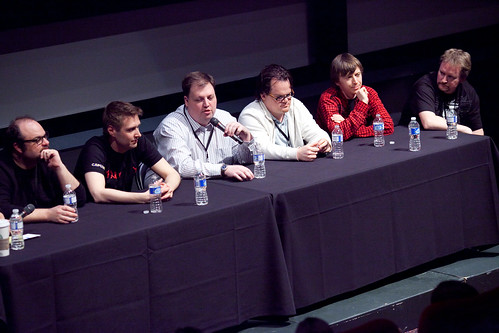
Photo Credit: Flickr, Merrill College of Journalism Press Releases
So, what is multimedia technology? This type of technology refers to a variety of tools that instructors and educators often utilize in the educational realm. These tools can range from projectors to digital blackboards, or from auditory to computers. The combination of these resources together provide for an interesting and often exhilarating learning experience. When I was coming along in through the public school system, my school's budget barely got us computer labs. Anything other than that was unexpected and greatly appreciated. We did not have access to the internet or the availability of youtube and powerpoint, so are teachers did as best as they could with the limited resources they had. In most of my classes, the teacher and the textbook were the two main sources of information. This left most of the students with two undesirable choices; and, if the student hated traditional reading and did not get along with that particular teacher...well, let's just say that the student's calender year was not one of longevity. Fortunately for many students and teachers today, technology has helped to pave the way for multiple educational resources and more exciting learning experiences. There are a myriad of ways for educators to inform their students today. "Multimedia and digital technologies use words and pictures as well as sound, voice, and animation to present educational ideas and information in creative, engaging, and memorable ways." (Edwards, Malloy, Verock O'Loughlin, & Woolf, 2014, pg. 217) Most students just couldn't bare to hear the voice of some of their teachers for the entirety of the class, so having digital sounds and voices helps to level the playing field, so to speak.
Throughout the history of education, most students have learned more effectively when their learning involved a combination of materials, all in one setting at the same time. Well, this is what multimedia devices are able to due. Teachers who are able to incorporate different sources of materials within their educational environment, these teachers are able to reach higher learning levels for most of their students. For instance, most of my teachers used blackboards when I was in school. The blackboards were very limited in what they could do. However, add a projector with audio recording, and you just added a little something extra to the learning experience, especially for the students who are auditory in their learning style. In addition to addressing different learning styles while using a combination of resources, a good hands-on approach with multimedia technologies allows for a more in-depth learning experience for the students. "Multimedia uses computers to present text, audio, video, animation, interative features, and still images in various ways and combinations made possible through the advancement of technology." (Lovetto, 2014, pg.1)
Tech Tools: Digital Projectors are able to display electronic images at a rate much faster than teachers in the older days could change a slide (by hand) on an overhead projector. These digital projectors work great for images and pictures.
<iframe width="420" height="315" src="//www.youtube.com/embed/LTNvb47Jp_g" frameborder="0" allowfullscreen></iframe>
Summary & Connection
The more effective educators are the ones who are learning how to incorporate multimedia technologies into the learning environments. What teachers cannot do in an 8 hour class day, multimedia technologies will be able to compensate for the lack. New technological devices are what most students are into these day, and teachers and educators have to be able to effectively use these materials in combination inside the classroom for a more effective and real learning experience for the students. The many different learning styles of the students have a better chance of being address in a multimedia driven atmosphere. Multimedia technologies are not just fun for the students, but it can be exciting for the teachers as well.
Resources
Edwards, S., Maloy, R., Verock-O'Loughlin, R.E., & Woolf, B. (2014) Transforming Learning With New Technologies, Boston, Massachuettes: Pearson
Loretto, P., (2014) About.com Internship. The Definition of Multimedia. Retrieved 26 Mar 2014. Web n.d.

